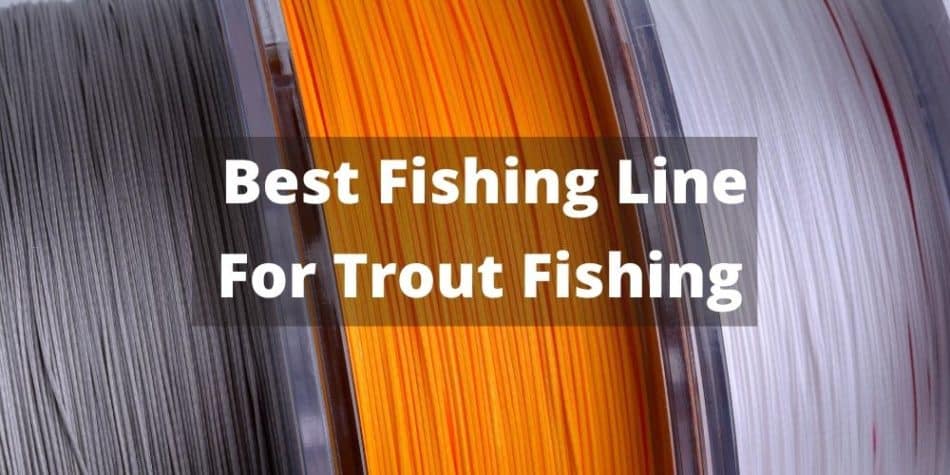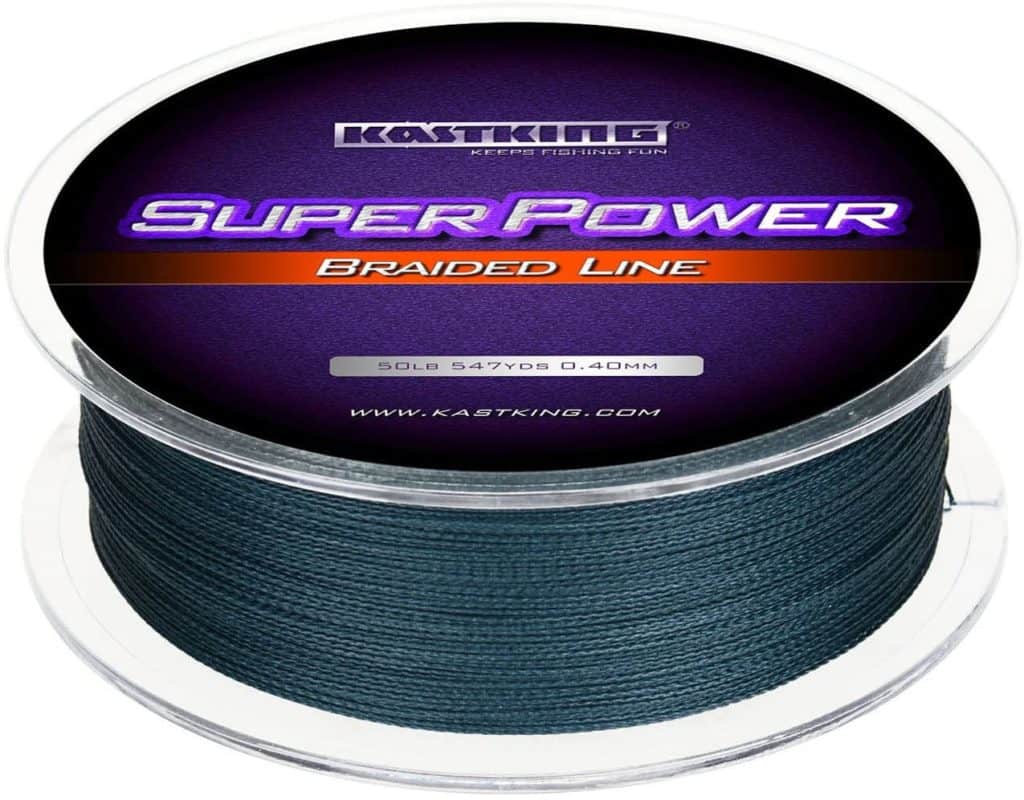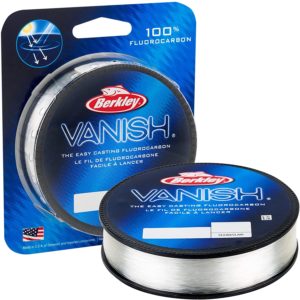Picking the right fishing line is a critical step to fishing. Choose a line that is too light and a big fish can easily break your line. Choose a line that is too heavy and you risk the trout spotting your line and not biting your bait.
Luckily, there are multiple right answers and it all depends on a few factors such as how you’re fishing for the trout, how big the fish are, and your personal preference. That being said, below is the quick answer as to the best fishing line setup for trout.
What is the best type of fishing line for trout? For any type of trout fishing, the main line should be 10+ pound test braided, monofilament, or fluorocarbon line. You need to use a lighter leader line so 6 pound test fluorocarbon is ideal. Fluorocarbon is the preferred line when trout fishing since trout can get easily spooked and fluorocarbon is the most invisible underwater.
My recommended setup:
I use 30 pound braided main line and 6 pound fluorocarbn leader line. This setup can be used for trout, bass, catfish, and even salmon fishing. The best part of this setup is I just need to change my leader line to target different fish. The 30 pound test main line is strong enough for all the fish I go after so no need to swap poles.
This means you can carry one pole and fish for a ton of different fish. I noticed that being lightweight when fishing is never a bad thing versus having to change poles for different fish.
Quick note: I only use fluorocarbon for my leader line. You can use fluoro for your entire spool but it’s expensive. I prefer braided for my main line since it has the smallest diameter for the same pound test line. This means you can spool more main line so you should not have to re-spool your rig ever again.
Braided, Fluorocarbon, or Monofilament Fishing Line
When looking at fishing lines you have 3 main options: braided, fluoro, or mono. Each of these have their pros and cons so I will briefly go over each one to help you choose the right type.
Braided Line
Braided fishing line has gotten a lot of positive attention from anglers for a few good reasons.
First braided line has the smallest diameter for the same pound test. This means 30 pound braided line is thinner than 30 pound mono or fluoro. The benefit of thinner but stronger line is that you can spool more on your reel and it also cuts through the water better than other lines.
Braided line also does not stretch which means it is very sensitive to every fish nibble and bite. This feature makes braided line a fan favorite for bass anglers over fluoro or mono. Being able to jig a worm and sense that a fish is interested is helpful for any type of fishing whether it’s bass or trout.
The one downside to braided line is that it is highly visible in the water. It looks like metal rope which means fish can easily spot your line. This is why you must use monofilament or fluorocarbon for your leader line when using braided main line.
Fluorocarbon Line
Fluorocarbon is the fan favorite among trout anglers and for good reason. This line is nearly impossible to see when submerged in water. Trout are known to be shy fish so this reason alone makes fluorocarbon the best fishing line to use for trout.
A few other benefits to fluorocarbon is that it has low memory, doesn’t stretch too much, and is stronger against abrasion than monofilament. All of this means that fluorocarbon has great properties that make it a preferred choice over mono.
Fluorocarbon is a heavier line which means it will sink quickly including your bait or lure. For some this is seen as a good thing while for others this may be seen as a negative. if you are trying to fish with Powerbait and want your bait to float then this is not ideal. However, I have not noticed any significant downsides to this line being slightly heavier than other options.
The only downside I have noticed with fluorocarbon is that it is very expensive line. However, if you don’t mind spending the money then I would get this line. The price of this line is why I only use fluorocarbon as my leader line so I can extend how long a fluorocarbon spool will last me.
Monofilament Line
Monofilament is still the most popular fishing line used by most trout anglers. This line has been around the longest and simply gets the job done. It’s inexpensive, easy to handle, and comes in a variety of colors.
Monofilament does have some noticeable drawbacks compared to braided and fluoro. This line has high memory and is weaker against abrasion than fluorocarbon.
High memory line means that monofilament line can twist and tangle more often if you’re using a small spinning reel with a heavy pound test. If you notice that the line is tangling then try using lighter pound test or a bigger reel.
Monofilament line also might get rough and be prone to break easier if you’re fishing around rocks and logs. This can be resolved by feeling your line every so often to check for rough patches. Simply remove those parts of the line or else you risk losing your fish and tackle.
Overall, Monofilament is a great option when starting off or if you want to keep costs low. This line will work and you just need to purchase one spool of 4 or 6 pound test to go fishing.
Choosing the Right Fishing Line Weight
The main thing to consider when selecting the right fishing line weight, also referred to as test, is to plan how big the typical fish is that you’re fishing for. Ocean fisherman will use line that is 50 or 100 pound test whereas a trout fisherman might only use 2 pound test.
There is no one size fits all answer that works for all species of fish. However, you can get a simple setup that works for most freshwater species including trout.
Most of the time, you can get away with using 2 to 6 pound leader line and 10 to 30 pound main line. I would recommend braided for the main line and fluorocarbon for the leader line. This way you can fish for trout, bass, catfish, walleye, and other common freshwater fish.
Selecting the Best Fishing Line Color
I’m going to start off by saying that you should just get the clear line instead of the colored ones. Keep it simple and try not to get too fancy with choosing colored fishing line.
I have researched and read many different studies about how fish cannot see pink at deeper waters or that green blends in with the surroundings. I think you will catch fish using these colored lines but you would’ve caught more fish if you just used the simple clear line.
If you are going to purchase colored line then please do not get the yellow color. This color is typically used by fly fisherman but they also have a nearly invisible fluorocarbon leader. Yellow is a very bright color that is easily spotted by any fish. Blue, green, pink, and red all have a chance of being harder to see based on the water color and depth you’re fishing at.
Best Line for Trout in Clear Water
The best fishing line for trout in clear water is going to be clear mono or fluoro fishing line.
Trout have great eye site and can see heavy pound test line or colored line. Clear monofilament line will also work although you may have to use a lighter line such as 2 or 4 pound test. This is why fluorocarbon is the preferred fishing line for trout since it is nearly invisible underwater. You can safely use fluorocarbon line up to 6 pound test without the trout noticing your line.
Braided line will be seen by trout in clear water but if you have a clear mono or fluoro leader line then this is completely ok. The point of braided is that it is strong, has a small diameter, and can take a lot more abuse over rocks and logs. You should not be tying your hook to braided line directly. The trout will notice.
Best Line for Trout in Murky Water
The best fishing line for trout in murky water is still going to be clear mono or fluoro fishing line. However, you can get away with heavier pound test or some colored lines depending on the color of the murky water.
For beginners and folks who like to keep it simple, I highly recommend just getting a clear line. This keeps your setup and tackle box simpler so you won’t need to lug around different colored strings to match the water color.
If you want to use braided line then make sure you still have a fluoro or mono leader. Even in murky water the trout can still get spooked at the last second if they spot a thick metal line tied to the bait.
Best Line for Fishing with Spinners and Spoons
Trout fishing with lures is one of the most fun ways to fish and catch trout. Whether you’re using a spinner or a spoon, you need to make sure you are using the right line for these shy fish.
Trout are known to strike hard when the lure is moving through the water naturally. If your hook ever gets caught on your line while you’re reeling in your lure then you know what I mean when I say that the lure movement matters.
Fishing line is crucial when it comes to lure movement while trout fishing. The fishing line needs to have low memory so it does not tangle or pull your lure in a strange way. The line also needs to be light or invisible enough so the trout do not see you reeling in your lure.
I recommend getting 4 to 6 pound test monofilament or 6 pound test fluorocarbon line. Personally I use 30 pound braided on my main line and 6 pound fluoro on my leader line. This line setup has allowed me to catch both bass and trout.
Best Line for Fishing with Bait
Bait fishing is the simplest method for catching trout and the easiest to setup. You can run all mono, fluoro, or mostly braided with a mono or fluoro leader.
The only thing you need to be mindful about is how your bait either floats or sinks in the water. If you’re fishing with a bobber then you need to make sure your bait sinks to the right depth. Whereas if you’re fishing off the bottom then your bait needs to be suspended off the bottom a certain height.
Depending on how you’re bait fishing, braided line might be a better option but you can use any fishing line for this method.
Personally I use 30 pound braided for my main and 6 pound fluoro for my leader. This setup allows me to quickly switch out baits or lures to target multiple fish species. I can also swap a Panther Martin spinner for a bait hook and change my fishing method depending on the trout.
Being able to respond to how the trout are acting is critical since these fish can be biting on moment and go silent the next. Make sure your line allows you to flexibility to fish for trout in multiple ways.
Frequently Asked Questions About Trout Fishing Lines
Q: What is the best pound test line for trout?
A: 6 pound test is the best and most universal line weight to use when trout fishing. If you’re using monofilament you might want to use a lighter test such as 2 or 4 pound test since monofilament is not as invisible as fluorocarbon.
Q: Is fluorocarbon line good for trout fishing?
A: Yes! Fluorocarbon is the best line for trout fishing since it is nearly invisible underwater. However, fluorocarbon is more expensive than other lines.
Q: How do I choose the right fishing line weight?
A: Think of how heavy the fish are that you might catch. Make sure your line’s pound test is at least that weight. So if you’re fishing for stocked trout then 2 pound or 4 pound test is plenty to reel those in.
Q: What color line is best for trout fishing?
A: The clear line is the best color for trout fishing by far. Trout have great eye site which makes these fish more shy than other species. If your line is brightly colored or visible in the water then the trout might not even bite your bait.
Q: What is the best line weight for trout fishing?
A: 6 pound test is the best and most universal line weight to use when trout fishing. If you’re using monofilament you might want to use a lighter test such as 2 or 4 pound test since monofilament is not as invisible as fluorocarbon.



